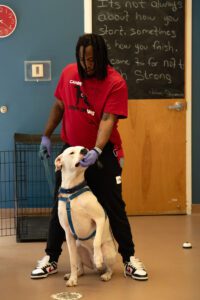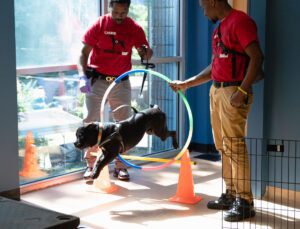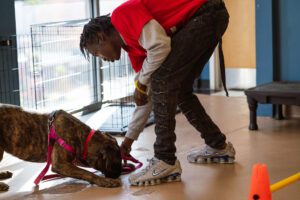A canine training program helps rehabilitate the formerly incarcerated.

 In 2021, Susan Jacobs-Meadows started Beyond the Bars, an out-of-custody rehab program that is part of the Canine CellMates organization. It helps resolve pending charges for men who are released from jail to serve the remainder of their sentence participating in the year-long program where they are taught to train shelter dogs. The hope is to increase the shelter animals’ chances of finding a forever home while also helping to rehabilitate the men.
In 2021, Susan Jacobs-Meadows started Beyond the Bars, an out-of-custody rehab program that is part of the Canine CellMates organization. It helps resolve pending charges for men who are released from jail to serve the remainder of their sentence participating in the year-long program where they are taught to train shelter dogs. The hope is to increase the shelter animals’ chances of finding a forever home while also helping to rehabilitate the men.
Participants come to Behind the Bars through referrals from the Fulton County District Attorney’s Office, the prisoner’s attorney or even a family member. The dogs primarily come from Fulton County Animal Services and are all sizes, colors and breeds.
“The intent is to expose prisoners to things that can help them succeed and make a conscious decision not to go back to jail,” Jacobs-Meadows says. “The dog-training component allows them to form a unique bond with animals that have been in a similar position: locked in a facility and unsure of what could happen at any moment.”
Program Participation
 As part of Beyond the Bars, which takes place at the Canine CellMates’ West Midtown facility, the men work with rescue dogs in a group training environment led by professional dog trainers. They learn their dog’s background, how to read its body language and about dog-handling skills.
As part of Beyond the Bars, which takes place at the Canine CellMates’ West Midtown facility, the men work with rescue dogs in a group training environment led by professional dog trainers. They learn their dog’s background, how to read its body language and about dog-handling skills.
“The men train the dogs using positive-reinforcement methods and teach them basic obedience cues like touch, sit, down, leave it and drop it,” Jacobs-Meadows says. “They can then move on to more advanced training dependent on the dog’s and handler’s aptitude.”
Phase 1 offers a highly focused curriculum during which conflict resolution, emotional competence, effective communication, mindfulness and relaxation techniques and goal setting are covered.
“We hold a graduation at the end of the first phase because it’s pretty impressive for the men to make it through the demands of this intensive segment,” Jacobs-Meadows says. “The dogs are available for adoption at any point, but they can’t leave until they graduate from Phase 1 of the program.”
Throughout the remaining three phases, the men’s participation is reduced over time. They continue to work with the rescue dogs, and they also concentrate on curriculum topics like building strength, letting go of anger and learning how to conduct an effective job search. So far, five classes have graduated from the program, about 25 men, and there are 14 individuals currently participating.
The Selection Process
 The Canine CellMates team does temperament assessments with the dogs before admitting them into the program. The pups need to be resilient since they will be living in a kennel environment for at least four months. They also need to accept being handled by various people and exposed to different scenarios.
The Canine CellMates team does temperament assessments with the dogs before admitting them into the program. The pups need to be resilient since they will be living in a kennel environment for at least four months. They also need to accept being handled by various people and exposed to different scenarios.
“We’re also looking for the greatest possible diversity in size, color and breed because we want everybody to support what we do,” Jacobs-Meadows says. “If we get too specific with only including large dogs or only pit bulls, for example, people may categorize our organization and move on.”
The formerly incarcerated men do not have dog-handling skills, so pups that have behavioral issues are not admitted into the program.
Happy Ending
The people who rescue dogs from Canine CellMates are often repeat adopters who see the program as a big benefit. Jacobs-Meadows says some people also adopt because they believe in the organization’s mission. The dogs who aren’t adopted never go back to the shelter; they live at the facility instead. “Once they’re a Canine CellMates dog, they always are,” Jacobs-Meadows says.
CANINE CELLMATES
678.528.2200
caninecellmates.org
@caninecellmates
Pets columnist at Simply Buckhead. Professional writer and editor. Proud animal rescue volunteer.














